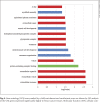The Identification of Gene Expression Profiles Associated with Granulomatous Mastitis
- PMID: 34602937
- PMCID: PMC8436716
- DOI: 10.1159/000507474
The Identification of Gene Expression Profiles Associated with Granulomatous Mastitis
Abstract
Background: Granulomatous mastitis (GM) is a rare chronic inflammatory disease of the breast. The current therapeutic effects of the antibiotic therapy and surgical or immunomodulatory (steroid) treatment are normally poor due to the unclear etiology.
Method: This study aimed to identify the differentially expressed mRNAs in GM tissues using RNA sequencing and further explored the functions of differentially expressed mRNAs resulting in GM. Moreover, we revealed the relationship between GM and breast cancer by shared highly expressed genes in GM tissues and breast cancer tissues.
Results: A total of 12,115 mRNAs were analyzed in the whole expression profile, and 207 mRNAs (136 upregulated and 71 downregulated mRNAs) were differently expressed between the GM tissues and normal tissues. The enrichment analysis showed that the differentially expressed mRNAs were enriched in the biological processes and played a significant role in the immune system. Besides, the genes expressed significantly highly in breast cancer tissues are found to be enriched with GM genes, which may explain the similar clinical features between breast cancer and GM. We also found that the HSD11B1 gene which was differentially expressed in GM was used as drug target of prednisone, which is a common treatment for GM.
Conclusion: This study is the first to use sequencing technology to elucidate the genetic mechanisms of GM. The finding of this study may have potential value in GM diagnosis and also provides potential drug targets for GM treatment.
Keywords: Etiology; Expression profiles; Granulomatous mastitis; RNA sequencing.
Copyright © 2020 by S. Karger AG, Basel.
Conflict of interest statement
The authors declare that there is no conflict of interest.
Figures





Similar articles
-
Granulomatous mastitis: a 10 year experience from a large inner city county hospital.J Surg Res. 2013 Sep;184(1):299-303. doi: 10.1016/j.jss.2013.06.047. Epub 2013 Jul 17. J Surg Res. 2013. PMID: 23890401
-
MAC mediates mammary duct epithelial cell injury in plasma cell mastitis and granulomatous mastitis.Int Immunopharmacol. 2022 Dec;113(Pt A):109303. doi: 10.1016/j.intimp.2022.109303. Epub 2022 Oct 14. Int Immunopharmacol. 2022. PMID: 36252469
-
Management of Granulomatous Mastitis Following Aesthetic Breast Surgery.Aesthetic Plast Surg. 2021 Jun;45(3):875-881. doi: 10.1007/s00266-020-01992-9. Epub 2020 Oct 8. Aesthetic Plast Surg. 2021. PMID: 33033878
-
Granulomatous mastitis.Arch Gynecol Obstet. 2004 May;269(4):233-6. doi: 10.1007/s00404-003-0561-2. Epub 2003 Dec 19. Arch Gynecol Obstet. 2004. PMID: 15205978 Review.
-
Association between Hyperprolactinemia and Granulomatous Mastitis.Breast J. 2016 Mar-Apr;22(2):224-31. doi: 10.1111/tbj.12552. Epub 2015 Dec 26. Breast J. 2016. PMID: 26705962 Review.
Cited by
-
The Effectiveness of Traditional Chinese Medicine Combined With Surgery to Treat Granulomatous Mastitis: A Propensity-Matched Analysis.Front Oncol. 2022 Feb 10;12:833742. doi: 10.3389/fonc.2022.833742. eCollection 2022. Front Oncol. 2022. PMID: 35223513 Free PMC article.
-
Whole-Exome Sequencing: Discovering Genetic Causes of Granulomatous Mastitis.Int J Mol Sci. 2025 Jan 6;26(1):425. doi: 10.3390/ijms26010425. Int J Mol Sci. 2025. PMID: 39796280 Free PMC article.
-
Granulomatous mastitis masking ductal carcinoma in situ: A case report with literature review.Biomed Rep. 2023 Dec 8;20(2):17. doi: 10.3892/br.2023.1705. eCollection 2024 Feb. Biomed Rep. 2023. PMID: 38169821 Free PMC article.
-
Tissue proteome analysis revealed an association between cancer, immune system response, and the idiopathic granulomatous mastitis.Med Oncol. 2022 Sep 29;39(12):238. doi: 10.1007/s12032-022-01845-2. Med Oncol. 2022. PMID: 36175807
-
Whole exome sequencing for identifying rare genetic variants related to idiopathic granulomatous mastitis.Clin Rheumatol. 2025 Apr;44(4):1843-1850. doi: 10.1007/s10067-025-07343-w. Epub 2025 Feb 24. Clin Rheumatol. 2025. PMID: 39992598 Free PMC article.
References
-
- Aghajanzadeh M, Hassanzadeh R, Alizadeh Sefat S, Alavi A, Hemmati H, Esmaeili Delshad MS, et al. Granulomatous mastitis: Presentations, diagnosis, treatment and outcome in 206 patients from the north of Iran. Breast. 2015 Aug;24((4)):456–60. - PubMed
-
- Barreto DS, Sedgwick EL, Nagi CS, Benveniste AP. Granulomatous mastitis: etiology, imaging, pathology, treatment, and clinical findings. Breast Cancer Res Treat. 2018 Oct;171((3)):527–34. - PubMed
-
- Lai EC, Chan WC, Ma TK, Tang AP, Poon CS, Leong HT. The role of conservative treatment in idiopathic granulomatous mastitis. Breast J. 2005 Nov-Dec;11((6)):454–6. - PubMed
-
- Yabanoğlu H, Çolakoğlu T, Belli S, Aytac HO, Bolat FA, Pourbagher A, et al. A Comparative Study of Conservative versus Surgical Treatment Protocols for 77 Patients with Idiopathic Granulomatous Mastitis. Breast J. 2015 Jul-Aug;21((4)):363–9. - PubMed
LinkOut - more resources
Full Text Sources
Other Literature Sources

